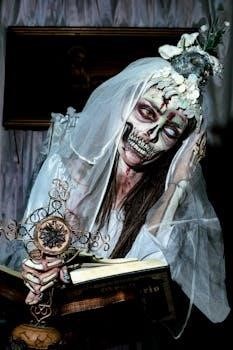Chronicle of a Death Foretold⁚ An In-Depth Analysis
Gabriel García Márquez’s “Chronicle of a Death Foretold” masterfully explores a murder that is known to the community, yet remains unstoppable. The narrative delves into themes of collective guilt, societal expectations, and the unreliable nature of memory, creating a complex and haunting tale.
Overview of “Chronicle of a Death Foretold”
Gabriel García Márquez’s “Chronicle of a Death Foretold,” published in 1981, presents a gripping narrative centered around the foretold murder of Santiago Nasar. The story unfolds in a small Colombian town, where the entire community is aware of the impending crime, yet fails to prevent it. This paradoxical situation forms the core of the novel’s exploration of collective responsibility and the complexities of human behavior.
The narrative structure deviates from traditional detective stories, as the reader knows the outcome from the beginning. Instead, the focus shifts to understanding the circumstances that led to Santiago Nasar’s death and the roles played by various townspeople. Márquez employs a fragmented, almost journalistic style, piecing together accounts and memories from different perspectives. This approach highlights the subjective nature of truth and the difficulty of reconstructing past events accurately.

Central themes in the novel include fate, free will, honor, and machismo. The story challenges the reader to consider whether Santiago Nasar’s death was truly inevitable or whether individual actions could have altered the course of events. The concept of honor, particularly within the context of a traditional Latin American society, plays a significant role in shaping the characters’ decisions and justifying their actions. Ultimately, “Chronicle of a Death Foretold” is a powerful exploration of human nature, societal pressures, and the enduring impact of the past.
Narrative Structure and Style
“Chronicle of a Death Foretold” distinguishes itself through its unconventional narrative structure, resembling a journalistic reconstruction more than a traditional novel. Márquez employs a non-linear timeline, beginning with the explicit announcement of Santiago Nasar’s death and then circling back to explore the events leading up to it. This “chronicle” approach creates a sense of impending doom, as the reader is constantly aware of the tragic outcome.
The story is narrated by an unnamed character who returns to the town years later to piece together the events. This narrator relies on fragmented memories, testimonies from townspeople, and his own recollections, resulting in a narrative that is both subjective and incomplete. Multiple perspectives are presented, often contradicting each other, highlighting the elusive nature of truth and the fallibility of human memory.
Márquez’s writing style is characterized by vivid imagery, sensory details, and a blend of realism and magical realism. He seamlessly integrates elements of folklore, superstition, and dreamlike sequences into the narrative, blurring the lines between reality and fantasy. The use of foreshadowing is prominent, with numerous omens and premonitions hinting at Santiago Nasar’s fate. Furthermore, the concise and direct prose contributes to the sense of urgency and inevitability that permeates the novel.
Themes of Fate and Free Will
“Chronicle of a Death Foretold” grapples with the complex interplay between fate and free will, questioning whether Santiago Nasar’s death was an unavoidable destiny or a consequence of individual choices. The title itself suggests a predetermined outcome, and throughout the novel, there are numerous instances of foreshadowing and omens that seem to seal Santiago’s fate.
The townspeople are aware of the Vicario brothers’ intention to kill Santiago, yet their actions, or lack thereof, contribute to his demise. Some individuals attempt to warn him, but their efforts are thwarted by chance encounters and miscommunications. Others simply stand by, passively accepting the impending tragedy. This collective inaction raises questions about the extent to which individuals are responsible for shaping their own destinies and the destinies of others.
While the novel emphasizes the power of fate, it also acknowledges the role of free will. The Vicario brothers, despite their declared intention, have opportunities to deviate from their course. Santiago Nasar, too, could have altered his fate by heeding the warnings he received. Ultimately, “Chronicle of a Death Foretold” leaves the reader to ponder the extent to which individuals are truly free agents or merely puppets of destiny, trapped within a web of social expectations and predetermined events. The novel suggests that both fate and free will contribute to the tragic outcome.
The Role of Honor and Machismo
In “Chronicle of a Death Foretold,” honor and machismo serve as powerful forces that dictate the actions and motivations of many characters, particularly the Vicario brothers. Their decision to murder Santiago Nasar is rooted in the perceived stain on their family’s honor caused by Angela Vicario’s loss of virginity before marriage. The brothers feel compelled to avenge this dishonor, viewing it as their duty to restore their family’s reputation within the community.
Machismo, the exaggerated sense of masculinity and male dominance, further fuels their actions. The brothers believe that they must act decisively and violently to prove their manhood and maintain their social standing. Their adherence to this code of machismo blinds them to the moral implications of their actions, leading them down a path of irreversible consequences.
The community’s reaction to the impending murder also reflects the pervasive influence of honor and machismo. Many townspeople are aware of the Vicario brothers’ intentions, but they do not intervene, either out of fear or a sense of complicity with the prevailing social norms. The concept of honor trumps compassion and justice, creating an environment in which a young man’s life is sacrificed to uphold a rigid and outdated code. The novel critiques the destructive consequences of these values.
Memory and Perception of Reality
“Chronicle of a Death Foretold” intricately explores the fallibility of memory and the subjective nature of reality. The narrator’s investigation into the events surrounding Santiago Nasar’s death reveals conflicting accounts and fragmented recollections, highlighting how individual perspectives shape the understanding of a shared experience. The novel suggests that truth is not a fixed entity but rather a fluid construct influenced by personal biases, emotions, and the passage of time.
The characters’ memories are often unreliable, distorted by their own guilt, fear, or desire to protect themselves. Details are misremembered, embellished, or completely forgotten, creating a sense of uncertainty and ambiguity. The reader is left to question the accuracy of each account, forced to piece together the puzzle of what truly happened.
The narrative structure further emphasizes the elusiveness of reality. By presenting the story through multiple perspectives and non-linear timelines, García Márquez challenges the notion of a singular, objective truth. The reader is confronted with a kaleidoscope of interpretations, each offering a different angle on the same events. Ultimately, the novel suggests that the search for absolute truth is futile, and that reality is ultimately a matter of perception.
The Significance of the Title
The title, “Chronicle of a Death Foretold,” carries profound significance, immediately establishing the inevitability of Santiago Nasar’s demise. It functions as both a spoiler and a framework for exploring the complex circumstances surrounding his murder. The “chronicle” aspect suggests a detailed, historical account, yet the “foretold” element introduces an air of fatalism, implying that the events were predetermined and inescapable.
The title highlights the central irony of the novel⁚ despite widespread knowledge of the impending murder, no one effectively intervenes to prevent it. The villagers are aware of the Vicario brothers’ intent to kill Santiago, yet their warnings are either ignored, dismissed, or tragically misdirected. This collective inaction raises questions about individual responsibility, societal complicity, and the power of fate;
Furthermore, the title underscores the novel’s exploration of narrative and storytelling. By framing the events as a “chronicle,” García Márquez invites the reader to consider the role of language and representation in shaping our understanding of the past. The story becomes a reconstruction of events, pieced together from fragmented memories and conflicting accounts, ultimately questioning the possibility of ever truly knowing the truth.
Character Analysis⁚ Santiago Nasar
Santiago Nasar, the victim in Gabriel García Márquez’s “Chronicle of a Death Foretold,” remains an enigmatic figure throughout the narrative. He is presented as a young, affluent man of Arab descent, known for his charm, good looks, and involvement in the town’s social life. However, his character is largely defined by the perceptions and memories of others, leaving his true nature somewhat obscured.

Santiago is portrayed as a man of routine, rising early on the day of his death to prepare for the bishop’s arrival. This adherence to habit highlights his innocence and unawareness of the impending danger. He is also depicted as being somewhat detached and oblivious, failing to recognize the warnings that surround him.
Despite his apparent popularity, Santiago is also the subject of rumors and suspicions. He is vaguely accused of taking Angela Vicario’s virginity, the alleged motive for his murder. However, the truth of this accusation remains ambiguous, raising questions about Santiago’s guilt or innocence. Ultimately, Santiago Nasar becomes a symbol of fate, a victim of circumstance and societal forces beyond his control. His death serves as a catalyst for exploring themes of honor, justice, and the collective responsibility of a community.
Character Analysis⁚ Bayardo San Roman and Angela Vicario
Bayardo San Roman and Angela Vicario are central to the tragedy in “Chronicle of a Death Foretold,” representing contrasting aspects of societal expectations and individual agency. Bayardo, a wealthy and seemingly perfect bachelor, arrives in town and immediately decides to marry Angela, drawn by her beauty and perceived purity. He embodies the superficiality of societal values, valuing appearance and status over genuine connection.
Angela, on the other hand, is initially presented as a passive and unwilling bride; She admits to not loving Bayardo but is pressured into the marriage by her family, highlighting the limited agency women had in that society. However, after being rejected by Bayardo on their wedding night for not being a virgin, Angela undergoes a transformation.
She names Santiago Nasar as the one who defiled her, setting in motion the events leading to his death. While this act could be seen as a desperate attempt to regain honor, it also reveals a newfound strength and defiance. After Bayardo leaves, Angela begins to write him letters for years, eventually winning him back. This demonstrates a complex evolution of her character, from a submissive figure to a woman who actively shapes her own destiny.
Symbolism in the Novel

Gabriel García Márquez employs rich symbolism in “Chronicle of a Death Foretold,” adding layers of meaning to the narrative. The weather, particularly the persistent rain, serves as a symbol of impending doom and the pervasive sense of unease that hangs over the town. It foreshadows the tragic events and reflects the emotional turmoil of the characters.
Dreams also play a significant symbolic role, often acting as premonitions or warnings that are ignored or misinterpreted. Santiago Nasar’s dream the night before his death hints at the violence to come, highlighting the theme of fate and the characters’ inability to alter their predetermined course.
Birds, frequently mentioned throughout the novel, symbolize freedom and vulnerability. The image of birds flying away as Santiago is murdered suggests the loss of innocence and the escape of responsibility. The closed doors of the townspeople’s homes, as the murder unfolds, represent their collective guilt and their refusal to intervene, further emphasizing the theme of complicity.
Finally, the act of purification through violence is symbolized by the Vicario brothers’ relentless pursuit of Santiago, reflecting the distorted values of honor and machismo prevalent in the society.
Critical Reception and Interpretation
“Chronicle of a Death Foretold” has garnered significant critical acclaim, lauded for its innovative narrative structure, exploration of complex themes, and evocative prose. Critics have praised García Márquez’s masterful use of magical realism to blend the mundane with the extraordinary, creating a world that is both familiar and surreal.
Interpretations of the novel vary, with some focusing on the societal critique of honor culture and its devastating consequences. Others emphasize the themes of fate versus free will, examining the extent to which the characters are trapped by their circumstances. The unreliable narration and the fragmented nature of memory have also been central to critical discussions, prompting questions about the nature of truth and perception.

Some scholars view the novel as a commentary on collective guilt and the responsibility of a community in the face of injustice. The townspeople’s passivity and their inability to prevent Santiago Nasar’s murder have been interpreted as a reflection of societal apathy and the dangers of conformity.
Overall, “Chronicle of a Death Foretold” remains a subject of ongoing scholarly debate, celebrated for its literary merit and its enduring relevance to contemporary social issues.